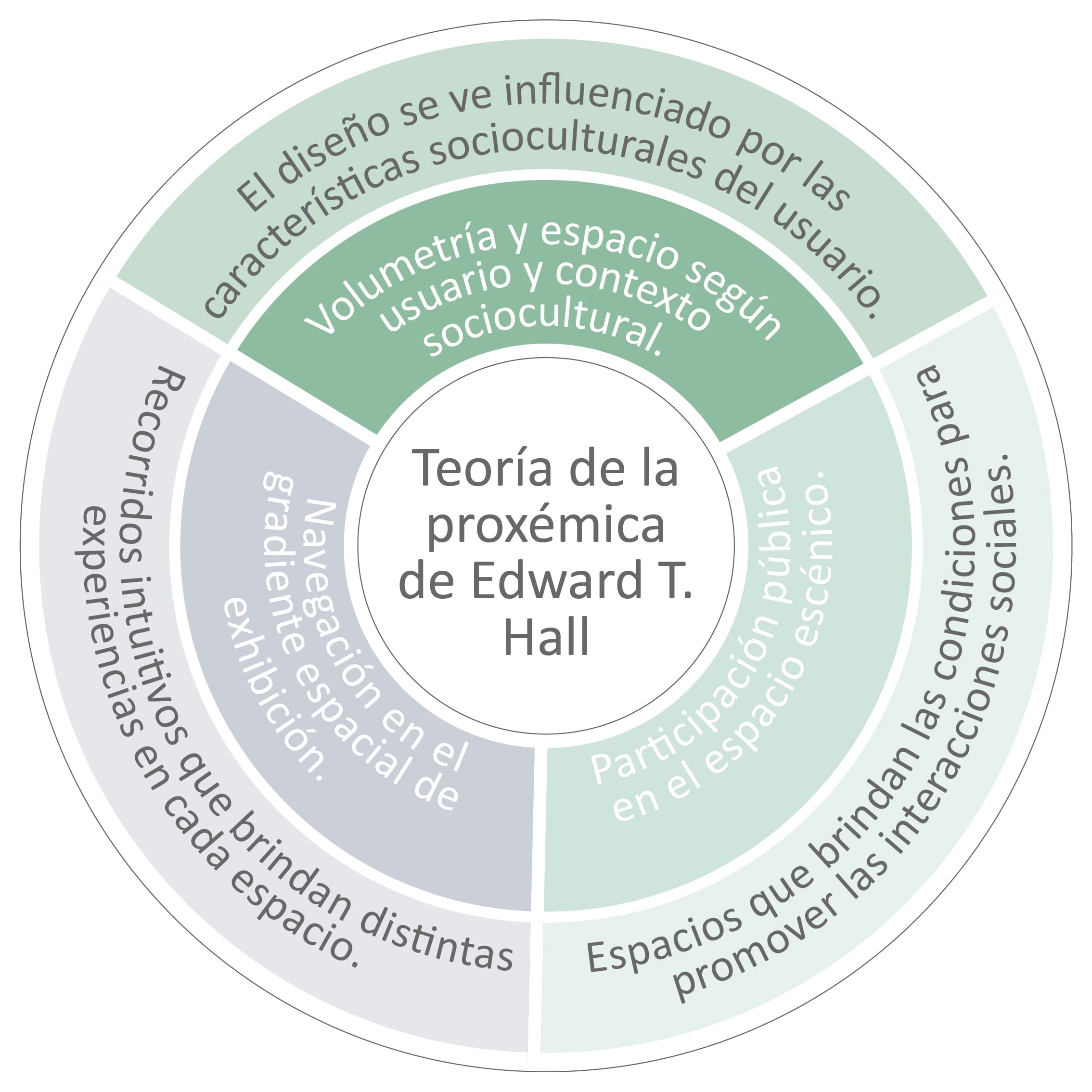Global proxemics
The influence of Edward T. Hall in cultural spaces
DOI:
https://doi.org/10.18861/ania.2025.15.1.3887Keywords:
Global proxemics, proxemic interactions, cultural space, social interaction, Edward T. Hall, spatial experience, cultural architecture, scenic space, cultural design, interaction spacesAbstract
The research article focuses on studying how the proxemic principles established by Edward T. Hall influence the design of exhibition and cultural dissemination spaces. A descriptive, qualitative, and non-experimental methodological approach was chosen; it was based on a scientific documentary review that included indexed journals, articles, specialized books, and research papers. From this review and investigative tools, three dimensions of study for the variable were determined; this allows for the identification of twelve criteria related to compositional characteristics, spatiality, architectural details, and materiality, which became design guidelines. Subsequently, a study of 5 global case samples was conducted to empirically validate these architectural criteria. The results showed that the application of space compression and expansion through different heights and ceiling levels is present in 100% of the case studies. The use of ramps and stairs as vertical circulation focused on design that encourages public participation and contributes to the cultural experience in the space was found in 80% of the cases. In 60% of the cases, the use of orthogonal and non-orthogonal Euclidean volumes applying blending and differentiating heights in their composition, generating identity in the context, and the use of orthogonal and non-orthogonal Euclidean volumes with central subtraction, producing organization from the scenic space as the main element, were the most used criteria. That being said, it is concluded that the application of the proxemic principles established by Edward T. Hall influences the design of exhibition and cultural dissemination spaces, providing architecture that promotes social interaction, public participation, and a fluid and diverse cultural experience within the space.
Downloads
References
Amayo, S. (2023). Centro cultural de arte urbano en el distrito del Callao [Tesis de pregrado, Universidad Peruana de Ciencias Aplicadas]. http://hdl.handle.net/10757/673294
Ayuntamiento de Camargo (2015) El futuro de los Centros Culturales en la Europa Creativa.
Buldaç, M. (2021). Mekanda Proksemi Kavramı ve Proksemik Düzenlemeler: Bauhaus Tiyaroları. Mimarlık Ve Yaşam, 6(3), 1033-1049. https://doi.org/10.26835/my.933680
Castro, M. (2016). Centro Cultural y de Comercio proyecto estructurante [Tesis de pregrado, Universidad Católica de Colombia]. http://hdl.handle.net/10983/8677
"Centro de arte Aranya / Neri&Hu Design and Research Office" 27 sep 2019. ArchDaily. Recuperado de https://www.archdaily.pe/pe/925607/centro-de-arte-aranya-neri-and-hu-design-and-research-office
"Centro PANEUM / Coop Himmelb(l)au" 26 feb 2018. ArchDaily. Recuperado de https://www.archdaily.pe/pe/888963/centro-paneum-coop-himmelb-l-au
"Cultural Center of EU Space Technologies / Dekleva Gregoric Arhitekti + SADAR + VUGA + OFIS architects + Bevk Perovic Arhitekti" 27 Dec 2012. ArchDaily. Recuperado de https://www.archdaily.com/310664/cultural-center-of-eu-space-technologies-dekleva-gregoric-arhitekti-sadar-vuga-ofis-architects-bevk-perovic-arhitekti
Espinoza, S. (2020). Centro comunitario de desarrollo social y cultural en Santiago de Surco [Tesis de pregrado, Universidad Ricardo Palma]. https://hdl.handle.net/20.500.14138/3202
Fernandez, A. (2022). Diseño de un hogar de refugio temporal para mujeres violentadas basado en la teoría de la proxémica de Edward Twitchell Hall en Trujillo – La Libertad, 2020 [Tesis de pregrado, Universidad Privada del Norte]. https://hdl.handle.net/11537/31451
García, D. (2023). Centro cultural y recreativo de integración social para el desarrollo del municipio de la Gomera, Escuintla [Tesis de pregrado, Universidad de San Carlos de Guatemala]. http://www.repositorio.usac.edu.gt/id/eprint/19320
"Gehua Youth and Cultural Center / Open Architecture" 01 Oct 2012. ArchDaily. Recuperado de https://www.archdaily.com/276957/gehua-youth-and-cultural-center-open-architecture
Hall, E. (1972). La dimensión oculta. Siglo XXI.
Herzog, J., y de Meuron, P. (2008). 201 CaixaForum Madrid. Herzog & de Meuron. https://www.herzogdemeuron.com/projects/201-caixaforum-madrid/
Jarvinen, T. (2021). Strategic Cultural Center Management. Routledge.
Larry, D. (2022). Proxemics and the Architecture of Social Interaction. Columbia Books on Architecture and the City.
Lui, E. (2015). The Aleatoric Milieu: An Architectural Theory on Proxemics and Navigation Design [Tesis de maestría, University of Waterloo]. http://hdl.handle.net/10012/9319
Marquardt, N., y Greenberg, S. (2015). Proxemic interactions: From Theory to Practice. Morgan & Claypool Publishers.
Méndez, A. (2013). La proxémica como una alternativa más para la investigación ergonómica. Estudios De Antropología Biológica, 7(1), 297-307. https://www.revistas.unam.mx/index.php/eab/article/view/42826
Park, M. (2018). 지역 문화예술 공연장의 활성화 방안 연구 : 부산문화회관 중심으로 [Tesis de Maestría, 동아대학교]. https://dl.nanet.go.kr/SearchDetailView.do?cn=KDMT1201847672
Pascale, M. (2018). El estudio de la proxemia como factor clave para el diseño ergonómico de espacios de uso colectivo [Tesis de maestría, Universitat Politècnica de València]. http://hdl.handle.net/10251/114791
Pérez, A. (2020). Estrategias de rehabilitación del Patrimonio Industrial: Caixa Fórum de Madrid, Medialab del Prado [Tesis de pregrado, Universidad Zaragoza]. https://zaguan.unizar.es/record/96394
Pettersson, I. (2022). Culture centre Björkhagen [Tesis de maestría, KTH Royal Institute of Technology]. https://urn.kb.se/resolve?urn=urn%3Anbn%3Ase%3Akth%3Adiva-316555
Piana, R. (2023). Siluetas de alienación: Reseña de Proxemics and the Architecture of Social Interaction, de Larry D. Busbea. Astrágalo: Cultura de la Arquitectura y la Ciudad, 32, 247-252. https://doi.org/10.12795/astragalo.2023.i32.14
Price, C. (2022). Measuring a Sense of Belonging at Museums and Cultural Centers. The Museum Journal, 65, 135-160. https://doi.org/10.1111/cura.12454
Rondon, J. (2024). Centro cultural calle de las artes [Tesis de pregrado, Universidad de San Buenaventura]. https://hdl.handle.net/10819/13449
Sáez, F. (2016). Proxemia y espacio dramático en el teatro pastoril del primer Lope de Vega. Anuario Lope de Vega, 22, 409-431. http://dx.doi.org/10.5565/rev/anuariolopedevega.152
Sanchez, V. (2023). Centro Cultural para el Parque Cultural Bicentenario en la Provincia Constitucional del Callao [Tesis de pregrado, Universidad Peruana de Ciencias Aplicadas]. http://hdl.handle.net/10757/668239
Takano, G., & Tokeshi, J. (2007). Espacio público en la ciudad popular: reflexiones y experiencias desde el sur. DESCO. https://biblioteca-repositorio.clacso.edu.ar/handle/CLACSO/6929
Vasquez, G. (2023). Arquitectura inflable para la innovación social en los centros rurales del Perú [Tesis de pregrado, Universidad Católica Santo Toribio de Mogrovejo]. http://hdl.handle.net/20.500.12423/6700
Villa, M. (2018). Condensador social: uma questão para a vida pública contemporânea. Oculum Ensaios, 15(1), 99-110. https://doi.org/10.24220/2318-0919v15n1a3743
"Zinder Cultural Center / De Zwarte Hond" 05 Nov 2017. ArchDaily. Recuperado de https://www.archdaily.com/882886/zinder-cultural-center-de-zwarte-hond

Published
How to Cite
Issue
Section
License
Copyright (c) 2025 Querbin Narciso Mauricio, Alberto Llanos Chuquipoma

This work is licensed under a Creative Commons Attribution 4.0 International License.
The journal and its contents are licensed under the Creative Commons - Attribution 4.0 International License (CC BY 4.0). It is possible to copy, communicate and publicly distribute its content as long as the individual authors and the name of this publication are cited, as well as the publishing institution (Universidad ORT Uruguay).

